My first disclaimer: the film photography that I do, is the film photography that I do, and may well not be the film photography that you do. Probably isn’t.
I’m an expat Brit project manager, based in Switzerland. Occasionally my work leads to short business trips to one of the various financial centres of Europe. If you overlook the glamour, the power, and the money (there isn’t much of any of ‘em) there is a perk for the aspiring street photographer: I’m often laid up for a few nights in some city centre hotel, with little to do after work other than to find a restaurant where I can have a meal, beer or two, and an uninterrupted read of a month old copy of New Scientist magazine. So I do all that, but I often try to take a few street snaps on the way to the restaurant, and almost always take a few night-time street snaps on the way back to the hotel; because I find myself feeling bolder at the prospect of photographing perfect strangers on the street after a damn good meal.
I wonder why.
Hic.
Insert a Contaxt T2
Anyways, my Leica M6 is a bit too heavy and valuable to be shoved into a corner of my briefcase, so after some research on Hamish’s website, amongst others, I thought I’d give the Contax T2 a try. And what a camera it is. The autofocus is snappy, the view finder is big and bright, the automatic film advance is quiet enough, it’s an Aperture Priority camera (as God intended it to be), and the aperture ring’s on the lens (where God intended it to be) does what it’s told (with a few caveats, more anon), and the +2/-2 exposure comp, erm, mostly compensates for the lack of a proper shutter speed dial. The camera is compact enough for briefcase duty, just about slips into a pocket of my business suit, and it looks great. Really, really great. So there.
In daylight use, I started off using it on fully automatic and maybe twiddling a bit with the aperture and exposure comp… and after a few months I found myself limiting the camera to F/8 (and be there) and that’s been that ever since. Auto everything else. Happy camper.
Night shooting woes
It was night use that had me stumped. ‘Cos what *should* have been the perfect night time street point ‘n’ shoot, isn’t… because of a combination of two design decisions made by the Contax people sometime back in the 1990s.
One, it’s an Aperture Priority camera, so in lower light the best you can hope for is some ridiculous shutter speed that makes handheld street shots impossible. Ok, so what about pushing the film a couple of stops? Yep, there’re two stops of exposure comp travel but even with ISO 400 film you still end up with a shutter speed of less than 1/15th of a second or worse. So that leads me to the second poor design decision: there’s no override to the DX coding. So I can’t push the film more than 2 stops.
So that was that.
I experimented with scratching the ISO 400 DX coatings into an ISO 800 or ISO 1600 pattern, but frankly after a few tries (Ilford XP2 doesn’t push nicely; the blacks look like a snowstorm on a dark night) I found I just couldn’t be bothered. Bloody DX coding. Sod it.
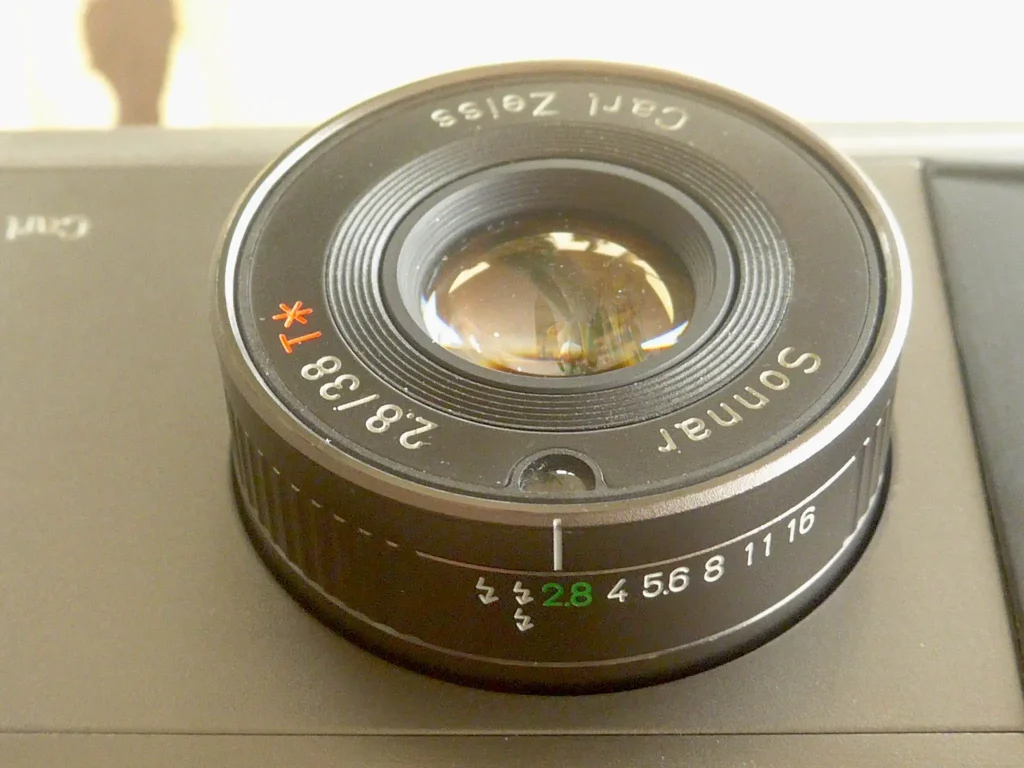
So one night I tried a few handheld night shots anyway, and set the aperture to F/2.8 to see what Program Mode could do… and boom, the flash went off because (hic) some idiot had turned the aperture way past F/2.8 and all the way to the flash setting. A quick look at the pickie above and you’ll see how that can easily happen even when sober. Now if there’s one thing that yer street photographer doesn’t want to do on a dark and rainy night in London, it’s to take a shot using flash. Of course it’d take a flash the size of a floodlight to light up a street, so there’s no obvious utility in it. But to be honest I was more worried about some hairy bloke with tattoos taking umbrage and shoving the T2 far up where the sun don’t shine.
So I turned it back to the normal F/2.8, and emptied the roll to see what I’d get when the film was developed…
The handheld Program Mode “F/2.8s” were, erm, very shaky. Unusable. But that one flash shot was really sharp enough to be used.
This moment triggered a realisation; on flash the T2 won’t use a slow shutter speed. In low light it, with the flash switched on, it will shoot all night long at 1/30th and F/2.8. I need the camera to work in flash mode without the flash. I can shoot at F/2.8 and 1/30th and the latitude of ISO 400 film, God bless it, can take care of the rest.
A bit ‘o tape
All excited at this discovery, I tested it with a taped over flash, and Boom! The flash flashed right through the tape. It’s that bright. Ok, so treble the tape, and Boom! Still coming through. So I used weapons-grade aluminium duct tape… and no boom, the flash stopped coming through the tape… but instead poured out through the window next to the flash window; the bloody flash internally leaks all over the place. Damn. So I duct taped over that window too… and that put paid to most of it. A bit of light leak from around various dials and other crannies, but nothing that’d draw attention on the street.
Hah.
But that next door window serves two purposes: it’s mainly for the autofocus; but it also lights up the frame-lines in the view-finder. Clever that. So I’d suppressed the flash, but I’d also lost two of the key virtues of the T2. Ah well, the price of progress. For a couple of months I scaled focused, and soon found that F/8 and scale focus is a hell of a lot easier than F/any thing else and auto focus. So I lived without it. But living with those missing frame-lines was another matter. Many, many framing problems.
But the main thing is that it somehow worked. Time and again I got 36 handheld night exposures which were at least viable… before the composition police came along and I chucked most of them away because no matter of equipment can compensate for pointing the camera in the wrong direction.
Time passed, and then I got back a bunch of films I’d taken during a daylight snow storm (another of my things) and shot after shot was so badly framed that no amount of cropping could rescue them. I seriously thought about buying a second T2, one for night and the other for daylight, but then had another thought.
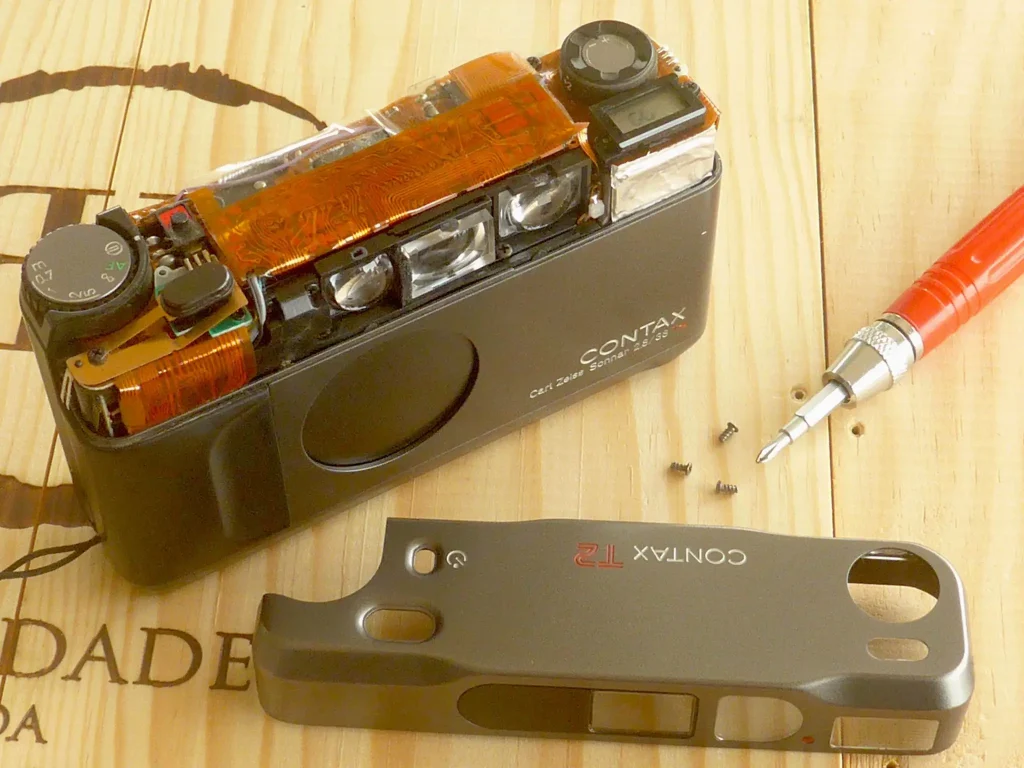
Surgery
Now for the *second* disclaimer. Please don’t try this at home, nor in the office, nor in the peaceful security of your shed. I did this because (a) I could always buy a second T2 if I ballsed it up and (b) I’m a prat and (c) I found out the hard way at the age of 10, when I was a younger prat, what it means to shove a bare thumb against a fully charged capacitor.
It bloody well hurts, that’s what.
So, I took the battery out of the T2, then unscrewed the top panel (three screws, easy enough) and then had a look see at what’s underneath. Ooerr, complicated. Aarrgghhhhh, and there’s the nasty capacitor waiting for me next to exposure comp dial. Avoid avoid avoid. But the flash unit was properly uncovered. So I cut a piece of duct tape, squashed it on “just so”, and used my finger nails to really get it on and around flash window. Then, after a bit of messing about positioning and repositioning the shutter button (the hardest part of the operation), I had the top panel back on. Down to the cellar, lights off, and a test flash (click, pop, weeeee) to see what I could see, which was nothing.
And it really does work. I have a F/2.8 and 1/30th of a second, night-time street T2 *with* auto-focus, and *with* frame-lines. And no nasty flash to scare the wildlife.
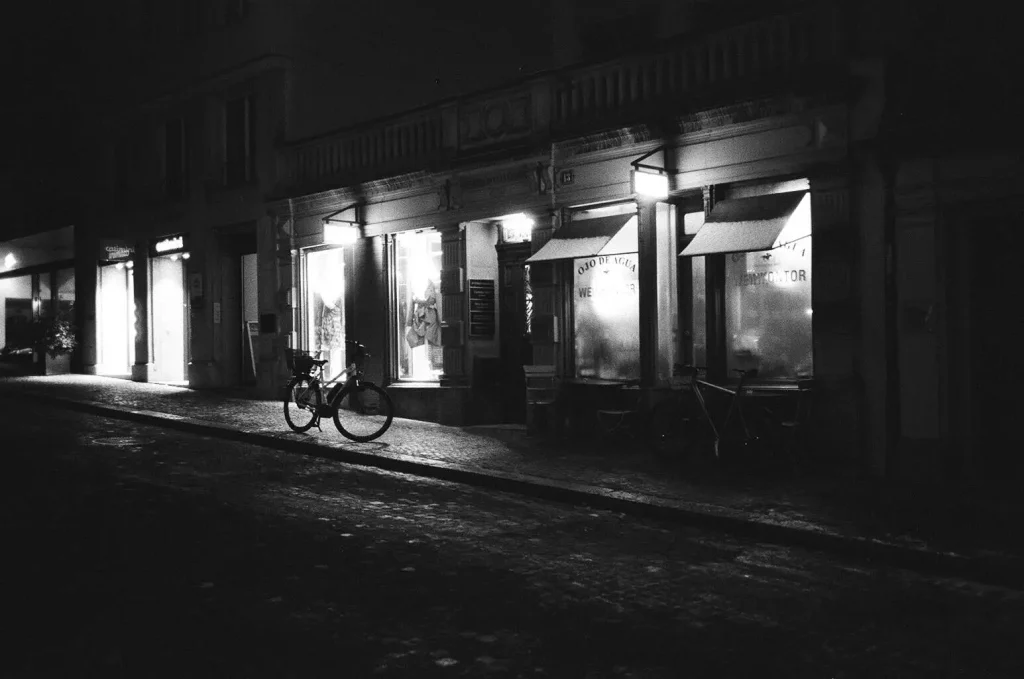
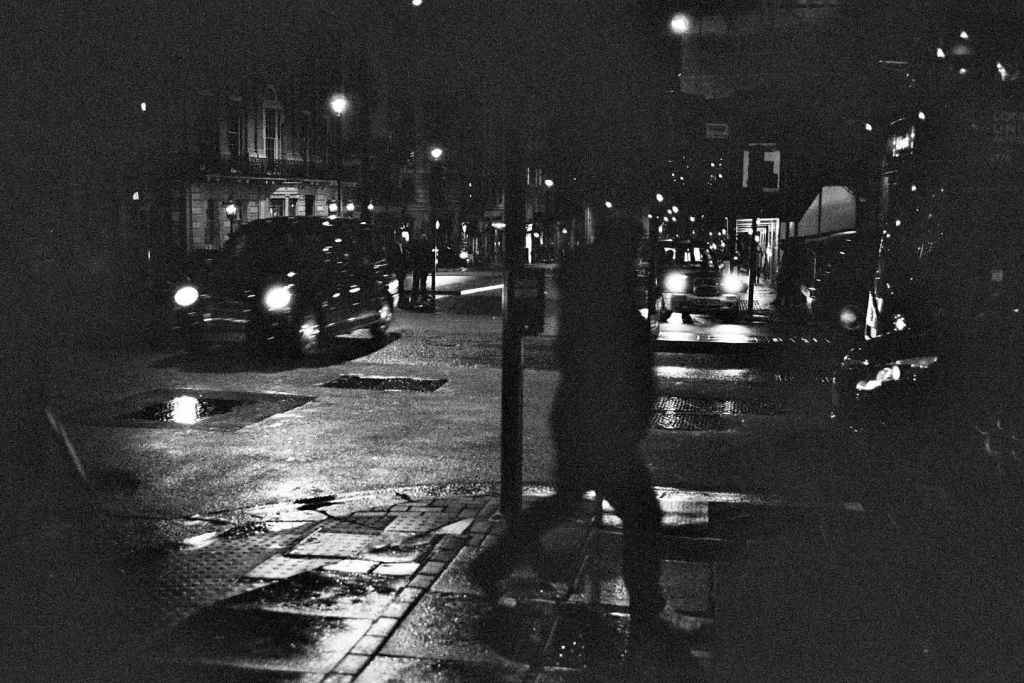
Cinestill 800T
The next part’s a bit of digression, so those uninterested in anti-halation layers can look away now.
A few months later I started playing with the currently trendy Cinestill 800T colour film, which has two virtues: it’s tungsten balanced, which is really what colour night time street photography needs, *and* it’s DX coded at ISO 800, so the T2 can makes something of it. So I gave it a go, and yes, it does give nice colours, especially at night.
But the film has one big drawback/feature, depending on your half empty/half full life philosophy. In order to repurpose this professional Kodak cine film for casual camera use, the “rem-jet” carbon layer on the back of the film wot allows it to whizz through a cine camera at speed has to be removed otherwise the carbon dissolves into the C41 chemicals during processing, buggering up both the lab’s chemicals *and* the developing machines. But that carbon layer serves two purposes: it slickens up the film for the cine camera *and* it acts as the anti-halation layer, which Wikipedia tells me means the layer of film that stops the light from the exposure coming straight through the film, hitting the film pressure plate where it reflects back into the film, and every else after that. Halation is bad, hence the anti-halation layer. In practice this results in annoying/pleasing halos around bright lights… such as street lights, car headlamps, and the brighter neon lights. Basically, what yer likely to encounter when shooting night-time street photography in any city on the planet.
Within reason, I’m fortunately in the feature/pleasing camp, although some halation halos are a bit too outrageous to be useable.
But one photo had me foxed… there was a band of red down the entire left side of a frame that looked like rectangular halo, but without any obvious source of bright light that I could recall. I put it down to “just one of those things” until I found a vaguely damning article on Cinestill 800T written by someone in the drawback/annoying camp; the back of many film cameras, including the T2, has a small window which allows you a limited view of the film canister inside. Useful, if you’ve forgotten which film you loaded days or weeks before, but not the best when you’ve got a repurposed film without an anti-halation layer.
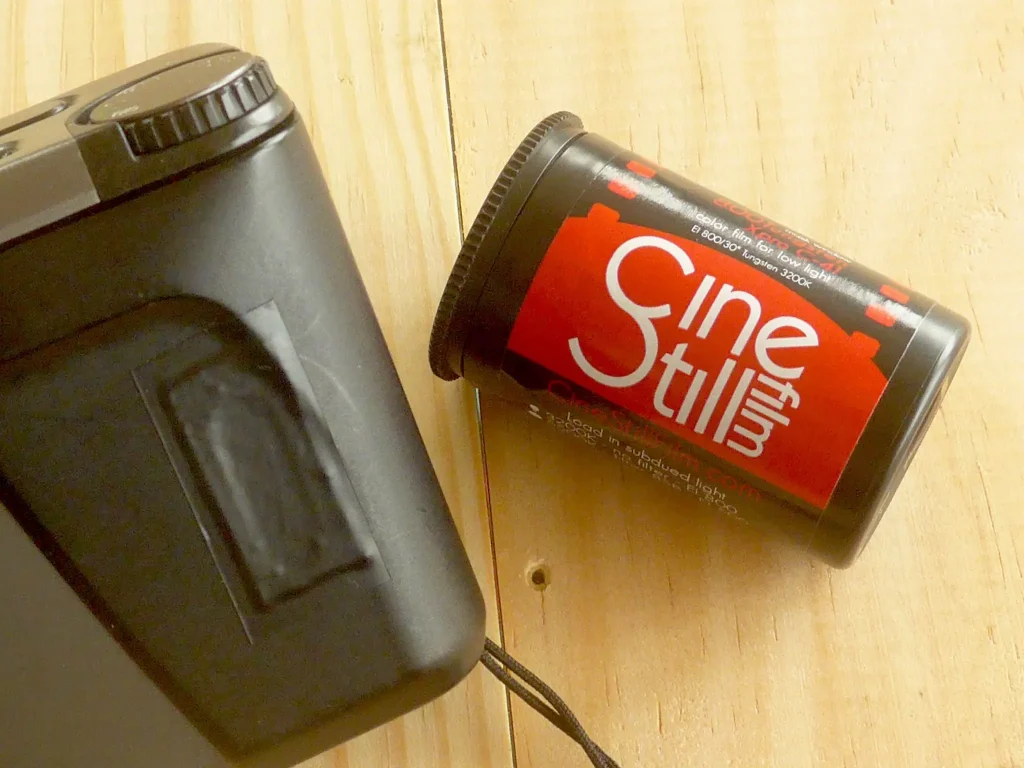
So I taped over the soddin’ window.
That’s nearly 2000 words to describe two bits of tape. On a film camera. In the digital age.
Don’t sit next to me on a long-haul aeroplane trip.
Ric
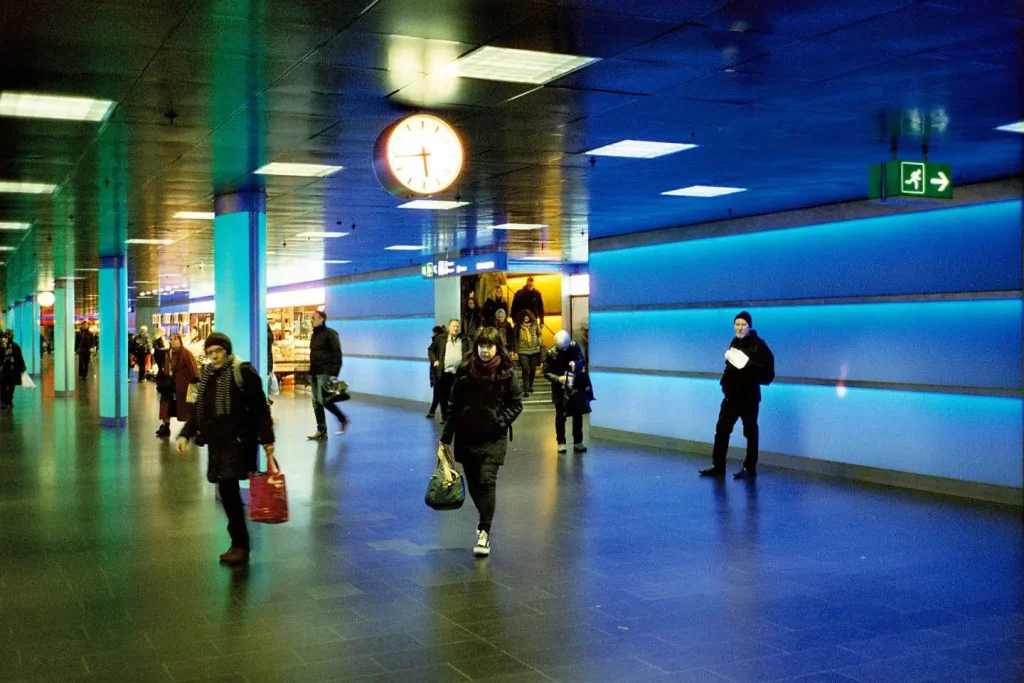
Share this post:









Comments
Hamish Gill on Hacking the Contax T2 for low light street shooting – by Ric Capucho
Comment posted: 03/04/2016
For the uninitiated, the reason this camera is so ideal for this mod is the fact that its autofocus is "Active". This means it works off a infrared beam and therefore doesn't rely on a point of contrast in the subject matter to focus like passive AF cameras do. This is the same reason the Olympus AF10 makes such a good choice for similar usage.
Ric, be brave! Cover the light meter sensor on the lens with some black sugru! It will effectively permanently lock the camera at 1/30th and f/2.8. With 3200iso film thats 3ev! Take some of the HP5 push it 3 stops and you'll be rocking!
Comment posted: 03/04/2016
Comment posted: 03/04/2016
Aukje on Hacking the Contax T2 for low light street shooting – by Ric Capucho
Comment posted: 03/04/2016
desmcs on Hacking the Contax T2 for low light street shooting – by Ric Capucho
Comment posted: 03/04/2016
Erman on Hacking the Contax T2 for low light street shooting – by Ric Capucho
Comment posted: 03/04/2016
Comment posted: 03/04/2016
Dexter on Hacking the Contax T2 for low light street shooting – by Ric Capucho
Comment posted: 03/04/2016
jeremy north on Hacking the Contax T2 for low light street shooting – by Ric Capucho
Comment posted: 04/04/2016
Other than that, I'd suggest getting a Rollei 35se and going manual.
Comment posted: 04/04/2016
Danny on Hacking the Contax T2 for low light street shooting – by Ric Capucho
Comment posted: 04/04/2016
Comment posted: 04/04/2016
Jon on Hacking the Contax T2 for low light street shooting – by Ric Capucho
Comment posted: 04/04/2016
You said that on f2.8 your shutter speeds were too slow (under 1/15th). Using the 2 stops of compensation surely would be enough wouldn't it? I've never shot in the street needing higher than 1600 film.
Second option, buy DX labels or print your own; you really don't have to scratch away at the cassettes. Thirdly, why not just use Delta3200 in the first place? I think DX brings up 1000ASA
All this hassle could be avoided of course if you switched to a Ricoh GR1v or similar with controllable ISO or a manual camera like Olympus 35RC/RD/SP, but you know that ;-)
As always, an entertaining article, thank you
Comment posted: 04/04/2016
Comment posted: 04/04/2016
Comment posted: 04/04/2016
Comment posted: 04/04/2016
Comment posted: 04/04/2016
Comment posted: 04/04/2016
Eugene Keogh on Hacking the Contax T2 for low light street shooting – by Ric Capucho
Comment posted: 04/04/2016
Comment posted: 04/04/2016
Tony on Hacking the Contax T2 for low light street shooting – by Ric Capucho
Comment posted: 04/04/2016
Tony
Comment posted: 04/04/2016
erik on Hacking the Contax T2 for low light street shooting – by Ric Capucho
Comment posted: 05/04/2016
Great article. As someone who shoots most often with my T2, I've struggled with lowlight at times. Especially in the winter when it's dark when I leave the office. Tend to shoot a lot of 800iso film in the winter months. This tip will definitely help out when needed. I'm somewhat thankful that when I bought my T2 the flash didn't work. Seems to only fire every 5-6 shots when in Flash mode. With further testing, I can power on/off the camera and make have it reset, essentially being sure that it will never fire when I don't want it too (and when I would want it to :/ )
Marco on Hacking the Contax T2 for low light street shooting – by Ric Capucho
Comment posted: 13/04/2016
You made me think of my Olympus XA as a night shooter too!
I always found the metering at night to be on the long exposure side... but now I know that with the flash setting (and without the flash) I can have a F4 and 1/30 or 1/15 with backlight compensation on.
Can't wait to try ;)
Jerry on Hacking the Contax T2 for low light street shooting – by Ric Capucho
Comment posted: 09/05/2016
Comment posted: 09/05/2016
Comment posted: 09/05/2016
Mark Brumell on Hacking the Contax T2 for low light street shooting – by Ric Capucho
Comment posted: 14/10/2016
Mark Brumell on Hacking the Contax T2 for low light street shooting – by Ric Capucho
Comment posted: 14/10/2016
Sendean cameras in London has spare parts for these wonderful Contax cameras!
Trey on Hacking the Contax T2 for low light street shooting – by Ric Capucho
Comment posted: 30/12/2018
Brian Dufour on Hacking the Contax T2 for low light street shooting – by Ric Capucho
Comment posted: 21/05/2019